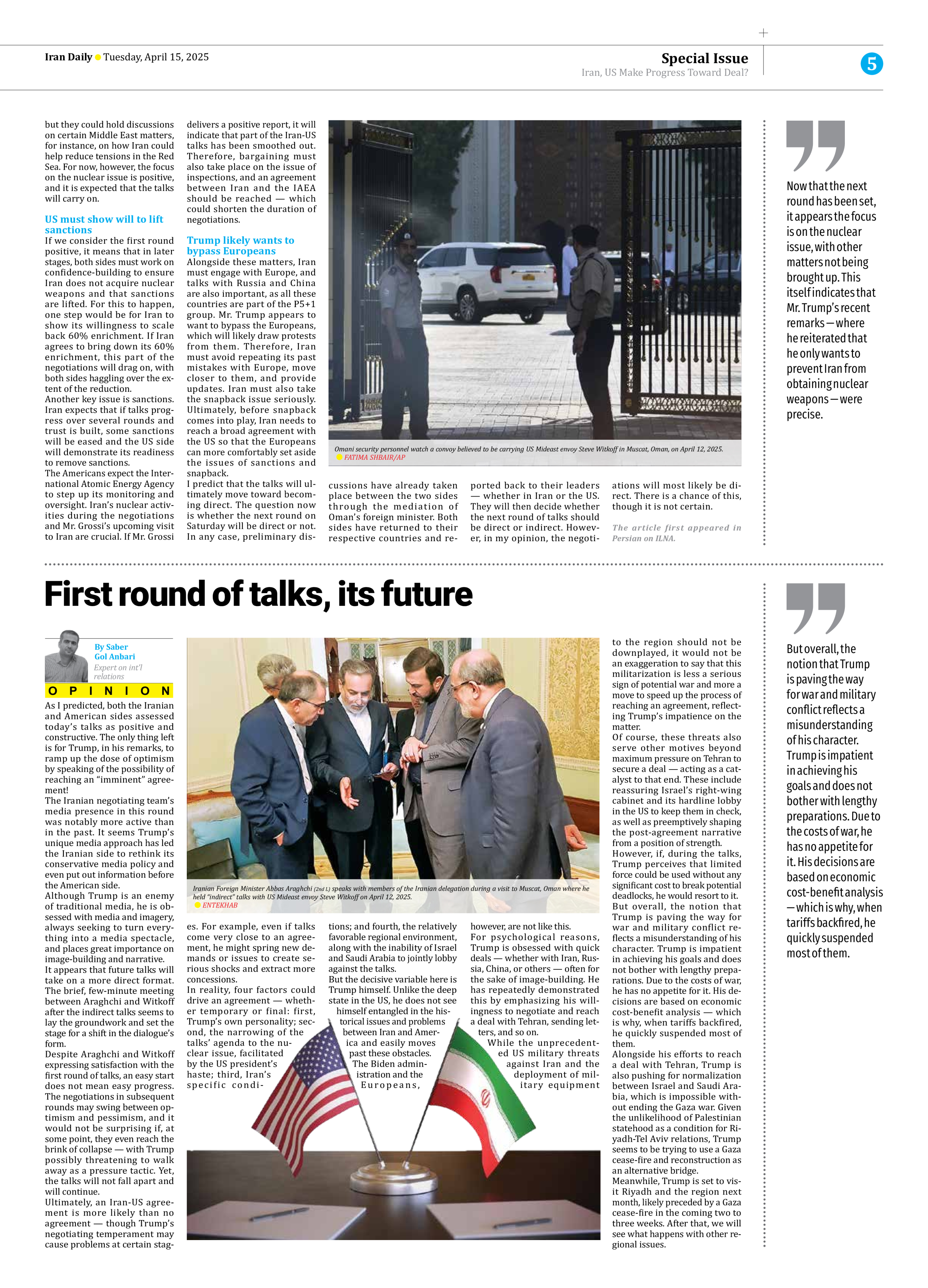
First round of talks, its future
By Saber
Gol Anbari
Expert on int’l relations
As I predicted, both the Iranian and American sides assessed today’s talks as positive and constructive. The only thing left is for Trump, in his remarks, to ramp up the dose of optimism by speaking of the possibility of reaching an “imminent” agreement!
The Iranian negotiating team’s media presence in this round was notably more active than in the past. It seems Trump’s unique media approach has led the Iranian side to rethink its conservative media policy and even put out information before the American side.
Although Trump is an enemy of traditional media, he is obsessed with media and imagery, always seeking to turn everything into a media spectacle, and places great importance on image-building and narrative.
It appears that future talks will take on a more direct format. The brief, few-minute meeting between Araghchi and Witkoff after the indirect talks seems to lay the groundwork and set the stage for a shift in the dialogue’s form.
Despite Araghchi and Witkoff expressing satisfaction with the first round of talks, an easy start does not mean easy progress. The negotiations in subsequent rounds may swing between optimism and pessimism, and it would not be surprising if, at some point, they even reach the brink of collapse — with Trump possibly threatening to walk away as a pressure tactic. Yet, the talks will not fall apart and will continue.
Ultimately, an Iran-US agreement is more likely than no agreement — though Trump’s negotiating temperament may cause problems at certain stages. For example, even if talks come very close to an agreement, he might spring new demands or issues to create serious shocks and extract more concessions.
In reality, four factors could drive an agreement — whether temporary or final: first, Trump’s own personality; second, the narrowing of the talks’ agenda to the nuclear issue, facilitated by the US president’s haste; third, Iran’s specific conditions; and fourth, the relatively favorable regional environment, along with the inability of Israel and Saudi Arabia to jointly lobby against the talks.
But the decisive variable here is Trump himself. Unlike the deep state in the US, he does not see himself entangled in the historical issues and problems between Iran and America and easily moves past these obstacles. The Biden administration and the Europeans, however, are not like this.
For psychological reasons, Trump is obsessed with quick deals — whether with Iran, Russia, China, or others — often for the sake of image-building. He has repeatedly demonstrated this by emphasizing his willingness to negotiate and reach a deal with Tehran, sending letters, and so on.
While the unprecedented US military threats against Iran and the deployment of military equipment to the region should not be downplayed, it would not be an exaggeration to say that this militarization is less a serious sign of potential war and more a move to speed up the process of reaching an agreement, reflecting Trump’s impatience on the matter.
Of course, these threats also serve other motives beyond maximum pressure on Tehran to secure a deal — acting as a catalyst to that end. These include reassuring Israel’s right-wing cabinet and its hardline lobby in the US to keep them in check, as well as preemptively shaping the post-agreement narrative from a position of strength.
However, if, during the talks, Trump perceives that limited force could be used without any significant cost to break potential deadlocks, he would resort to it.
But overall, the notion that Trump is paving the way for war and military conflict reflects a misunderstanding of his character. Trump is impatient in achieving his goals and does not bother with lengthy preparations. Due to the costs of war, he has no appetite for it. His decisions are based on economic cost-benefit analysis — which is why, when tariffs backfired, he quickly suspended most of them.
Alongside his efforts to reach a deal with Tehran, Trump is also pushing for normalization between Israel and Saudi Arabia, which is impossible without ending the Gaza war. Given the unlikelihood of Palestinian statehood as a condition for Riyadh-Tel Aviv relations, Trump seems to be trying to use a Gaza cease-fire and reconstruction as an alternative bridge.
Meanwhile, Trump is set to visit Riyadh and the region next month, likely preceded by a Gaza cease-fire in the coming two to three weeks. After that, we will see what happens with other regional issues.







